
New Housing Solutions LIVE Highlights
July 14, 2020 — Blog
Participants convened virtually over three days in July 2020 to address pressing housing challenges in affordability, community, and health. Scroll down for the highlights, replays, quotes, and more!
Day 3 – July 16
“We can house our homelessness by resetting our priorities. ‘Homes for All’ is an investment. It will employ thousands. We have the opportunity to create the country that we have been striving for.” – Ilhan Omar
“You can’t make a moral appeal to an immoral system” – Sacajawea ‘saki’ Hall
“This could be a perfect time to educate the new generations on how the housing world acted and what part it still has on segregation. That could create a path for them to rebuild housing and take it where it needs to be.” – Kristen Jeffers
“What is the primary goal of home ownership? Wealth building or intergenerational housing stability?” – Kristen Jeffers
Panel #1
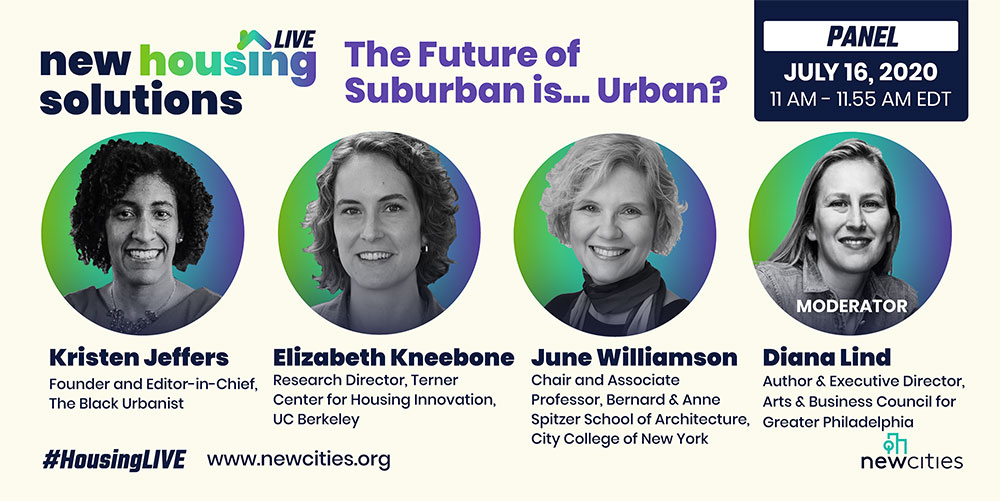
The “The Future of Suburban is… Urban?” was a well-stocked all-female panel. They did a fantastic job navigating new narratives of present-day suburbia, shattering popular perceptions of low density, car-dependent, white picket fence communities, and drawing attention to a new form of ‘sub‘-urban; narrowing the gap between the two. Here are some of the points raised:
- Low housing stock contributes to inequality. Insufficient housing supply negatively impacts affordability, making it harder for people to become homeowners. In America, homeownership relates directly to wealth, designed as the primary wealth-building tool. Tax policy penalizes renters and hinders a person’s access to economic stability.
- Language matters: in our media, in our policy, in our literature, in all discourse. Coding associated with the word “urban” and “suburbs”.
- Suburbia post-COVID. The appeal of suburbia is rising, as people want to leave dense city centers. Translating to increased desire for urban-type places (diverse, walkable downtowns, restaurant culture), however the adoption of such features in the suburbs presents issues of affordability, sustainability, etc.
Panel #2
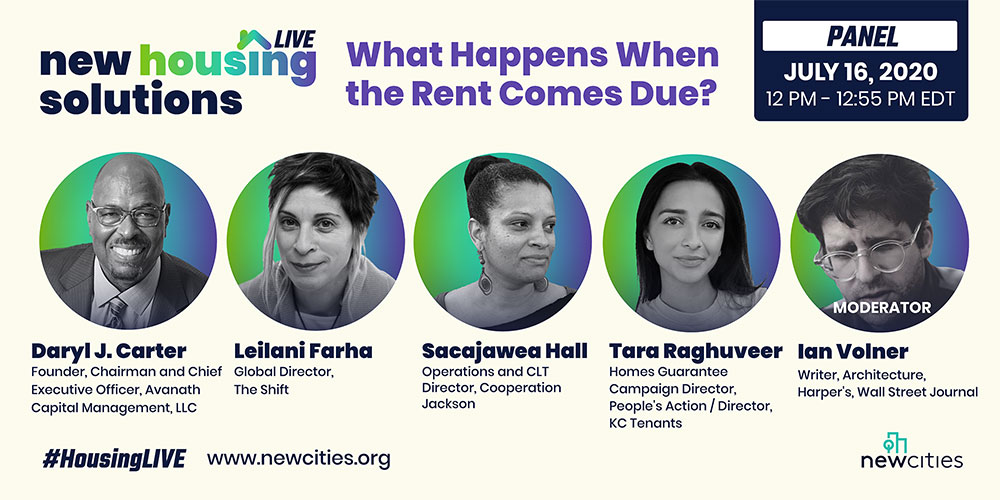
“What happens as the rent comes due?” featured many strong voices making the claim for housing as a human right. Panelists discussed how to empower renters, collective housing models that challenge traditional finance structures, and the need for progressive housing policy. Here are some of our notes:
- Housing is a human right, not a commodity: Recognizing housing as a fundamental human right at the legislative level can give the United States a framework and an accountability mechanism for its housing system.
- Community land trusts and cooperative housing are tools that communities can use to steward their own resources: Alternative housing models give residents negotiation power and offer leverage against the financial structure that deeply roots real estate in the economy.
- The housing crisis is not just a supply issue – it’s an affordable supply issue: The housing crisis is an undersupply of certain kinds of housing for certain kinds of people, namely those in the low income and/or marginalized brackets.
- There is room for government intervention: Public policy has a role to play when it comes to providing affordable housing. The Government should step in where there is misalignment between the incentives of for-profit development and the demand for affordable housing.
Keynote from Rep. Ilhan Omar: Homes For All, A Bold 21st Century Vision
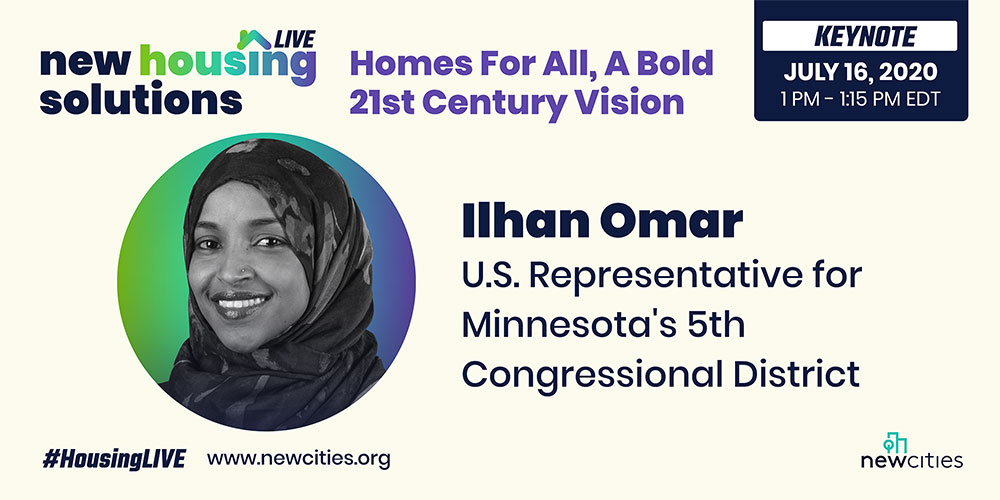
Congresswomen, Ilhan Omar, joined us on-screen to wrap up the event, her inspiring words invigorated us all to strive for equality, progress, and innovation in the housing landscape.
- “Housing provides stability. Housing provides security. Housing is a human right.” Ilhan Omar
The legislation introduced by Congresswoman Omar to make housing a priority and a mandatory part of the federal budget that would be paid for by equitably taxing the rich.
- Rent and Mortgage Cancellation Act – cancels rent and mortgages until after the pandemic.
- Homes For All Act – provides a long term vision to solve housing insecurity in the United States and create 12 million new public housing and private affordable units, which would be the most rigorous housing plan since the Great Depression.
- The current housing system is failing the very population that it is supposed to serve. Homelessness and housing insecurity are byproducts of that failing system.
- The COVID-19 pandemic has exacerbated the injustices in our current housing system that existed prior to the pandemic. COVID – 19, while incredibly challenging, provides a great opportunity for the United States federal government to step up and to shift its priorities and make affordable housing an agenda item for federal investment.
Day 2 – July 15
“It doesn‘t cost, not one single penny difference, to build a public housing unit vs. a market rate unit. If you’re gonna pay the same cost, why does the design have to look so different?” Daffney Moore
“Why is it that when it comes to some of the brown races, latinos and black‘s, it’s not called a racial enclave, it’s called the ghetto. Why is that? That‘s because of what‘s lacking there–It‘s the services that are lacking there, it’s the amenities that are lacking there” Angela Hurlock
“There has long been awareness of the need to spend money on education and housing to heal racial wounds. Reparation gives some type of closure. It allows people to move forward. Now is the time for that.” Issi Romem
“If you’re a white millennial, this is a great time to get close to the black community. We need to come together and be united as we’ve witnessed how transformative just the past month has been. You guys can change the world.” Albus Brooks
“In Mexico, Housing is a constitutional right. There are many programs available. In practice, the path is long and not always clear. The biggest challenge is the production of housing. It can not be seen just by developers, we need a full productivity chain.” Tatiana Bilbao
Panel #1
The opening panel “Millennials’ Missing Middle” examined the lack of housing typologies in urban areas to meet the needs of millennials – who unlike their parents, are not ready to move to suburbia. The conversation strove to answer the question: What kind of intentional housing do we want to build, to keep America‘s now largest generation in the city?
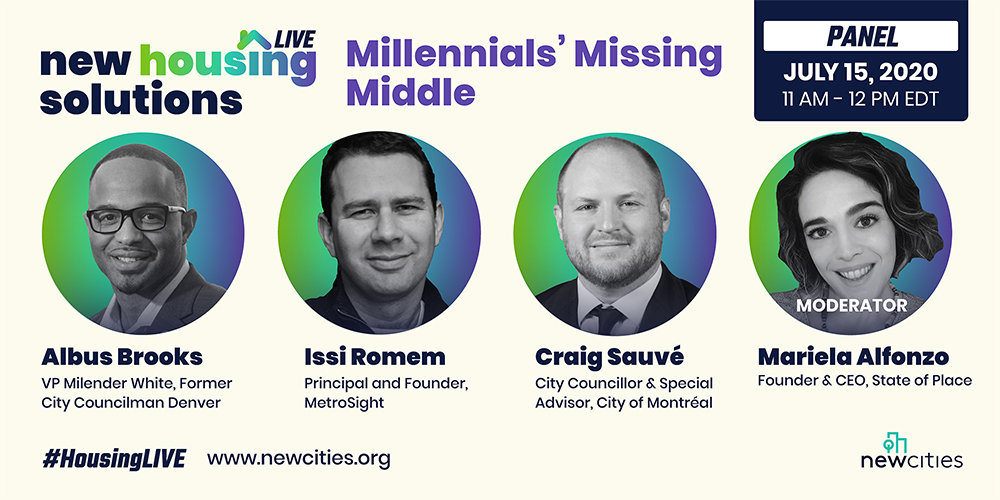
- Growth without gentrification is key for building inclusive cities: We must build inclusive cities that bring together both workforce and higher-educated millennials so that everyone can work together.
- Land use is the city’s most powerful tool: The control of land plays a big role in making cities and housing more equitable and affordable for millennials.
- The collectivization of resources can help build urban equity: Cities offer dynamism to millennials, and the collectivization of shared, public resources is one way to incentivize millennials to move to the city. Good public transit, green spaces, and carsharing are all ways to make urban living more affordable and equitable.
To bookmark: The Color of Law, A Forgotten History of How Our Government Segregated America, by Richard Rothstein
Panel #2

“Homes For All? The Future of Public Housing” featured panelists: Daffney Moore, Chief Opportunity Zone Officer, St. Louis Development Corporation, and Angela Hurlock, Chair, Chicago Housing Authority, tuning in from the U.S. Joined by Maria Vassilakou, Advisor and Advocate for Cities, Entrepreneur, who added an overseas perspective from the city of Vienna, Austria, where 60% of the population lives in affordable housing developments. This is what surfaced:
- Affordable housing must be viewed differently by leadership and the community. We must eradicate stigmas, including perceptions that only poor, uneducated, unemployed, and/or low income people live in public housing. In Vienna, the public housing model reflects the middle class allowing mixed income communities to be spread throughout the city.
- Public Housing (its history and current policies) in the United States is racialized. Since its inception, public housing in the United States has had a checkered history and suffered from many setbacks including persistent underfunding, lack of infrastructure maintenance, to racial and economic segregation, red-lining of communities, “not in my backyard” policies, and more.
- Public housing needs higher standards of quality, both in design and in terms of reinvestment. Public housing should be designed in the same way as market value houses if they both cost the same. Reinvestment will avoid displacements and/or force outs of neighborhoods since many leave public housing because there are not enough resources for them to succeed.
- Create an ecosystem for public housing to thrive where schools, jobs, supermarkets, businesses, retail stores, transportation, and more are accessible. This will take creative partnerships and cross-financing to ensure communities have all the amenities needed for people to thrive.
Panel #3
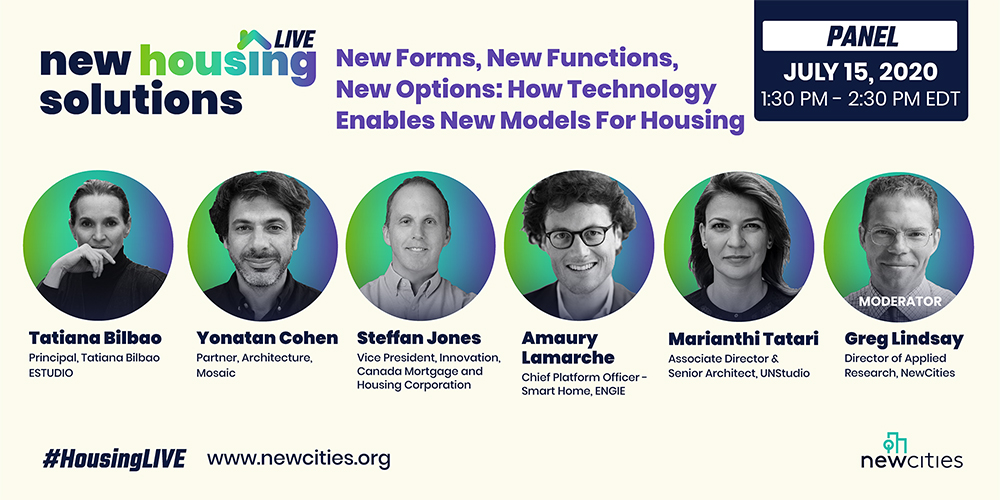
“New Forms, New Functions, New Options: How Technology Enables New Models For Housing” was exactly the conversation its name suggests. A truly international panel, hosting speakers from Mexico, Israel, France, the Netherlands, and Canada who shared their projects and creative work in the housing sector. Here are some touchpoints:
- Rethinking the role of the architect/designer as part of a system that includes the individual, community, and environment. Empowering the individual in the process to conceive and design their own living space through tools such as modular homes, 3D printing, AI and machine learning.
- Collaborative financing models are key to scaling up new projects.
- Technology cannot innovate itself out of the housing crisis, it must be supported by the rest of the system. Ideas such as opening up the construction industry to be more inclusive, UNStudio‘s Smart City, and Engie‘s energy-network alliance.
Networking Session
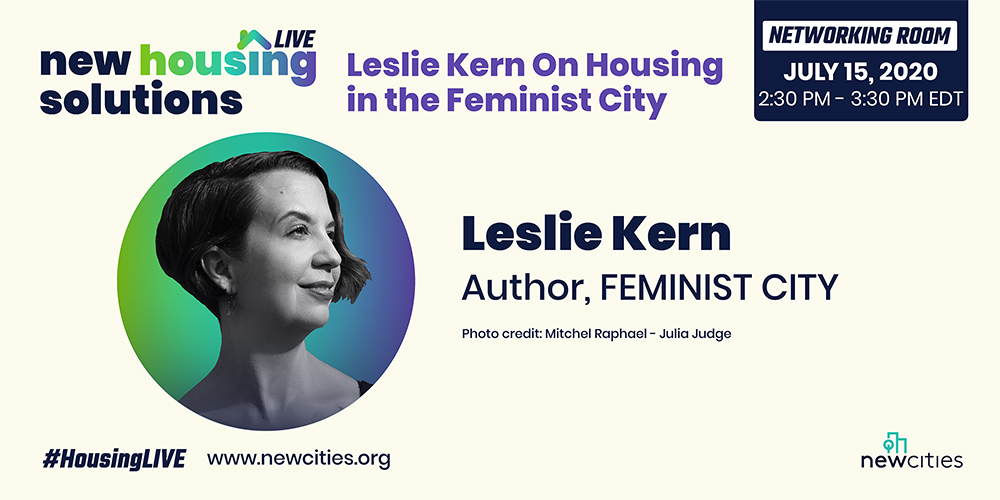
w/ Leslie Kern, Author of Feminist City, Mount Allison University
After-hours Session
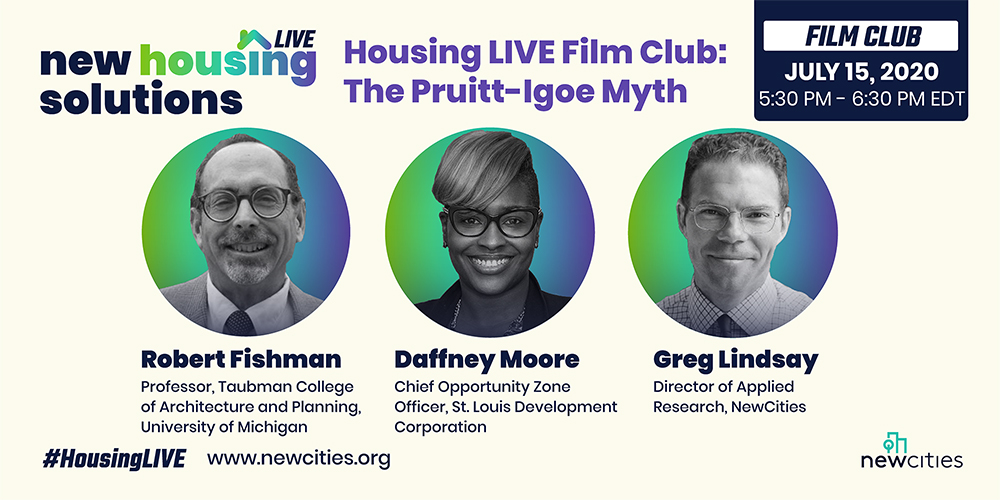
Add to your watchlist: The Pruitt-Igoe Myth – streaming free until July 31
Day 1 – July 14
“We are not going to build our way out of this problem” Eugene Jones
“California is the world‘s 6th largest economy, they have the capacity to have their own housing policy” Jonathan Woetzel
“People who struggle with housing policy, ask them where they slept last night? It’s imperative that we have a housing platform. We need the governments, but we also need cities, banks, and individuals to give, so we can house everyone” Jacqueline Waggoner
“What do you think is the ideal level of government solving this?”
The State is the right level to hold this debate. If we can’t have that discussion, what good the State actually does?” Conor Dougherty and Jonathan Woetzel
We need to focus on:
1- land availability
2- lower costs
3- reduce time
4- find money
5- an integrated plan.
Steffen Fuchs from @McKinsey
Panel #1
The opening panel “Rethinking Health and Homes“ set the tone for the conference. As speaker Jacqueline Waggoner, VP & Market Leader, Southern California, Enterprise Community, nicely put it, “COVID-19 has been able to daylight some critical challenges in the housing sector, and if we do better for others, we‘ll all be better together”. A solutions-driven exchange followed on affordable housing–and what it would take to meet the housing needs of the American population.

- Health and housing go hand in hand: COVID-19 has exposed the fissures of America’s housing system and has amplified the already existing inequities that plague public housing and homelessness.
- The United States lacks a national housing policy: Housing trails behind education, healthcare, and transportation and has fallen prey to partisan politics. The risk is an increase in homelessness and overall perpetuation of systemic racism and inequity. Congress should listen to the practitioners, to ensure resource allocation is data-driven and includes the wrap around services.
- Barriers to affordable housing must be broken down: Public-private partnerships are key to crafting housing solutions and creating a stronger housing system. Upzoning (changing the zoning codes) must include affordable housing. Approval processes must be sped up + red tape removed.
Panel #2
“Spotlight on Texas: New Approaches to America‘s Housing Crisis”, led by the City of Dallas‘ Director of Communications, Outreach and Marketing, Catherine Cuellar, was an informative session covering the past, present, and future of housing in Dallas. Despite its localized subject stream, panelists incorporated relatable examples and proposed holistic solutions for listeners tuning in from all over.
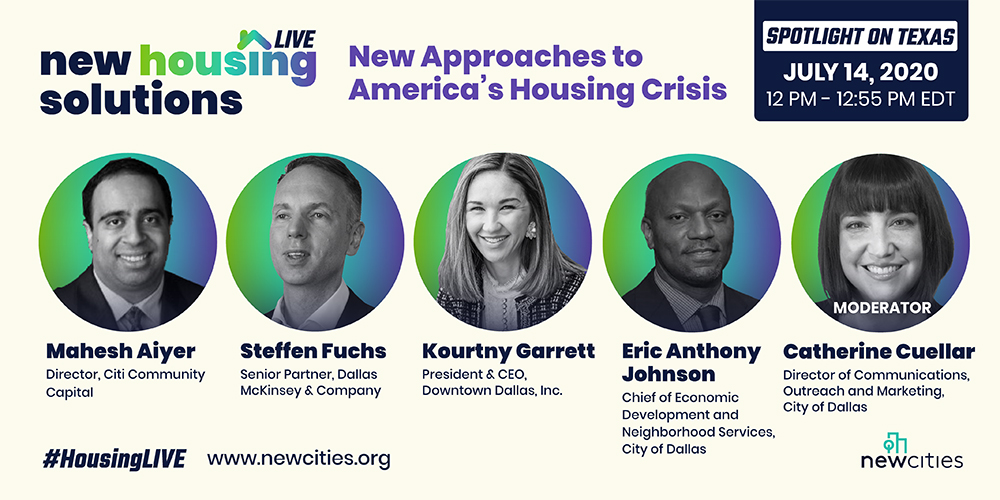
- Housing accessibility is not solely a housing issue, but has lots do with economic recovery: The lack of affordable housing affects all segments of community life and is intertwined with a city’s economic development, expansion in economic opportunities, and lack of income increases over time. If people are paying more in housing costs, they are in a weaker position to support their communities and local economies.
- The historical context of Texas is crucial to understanding its rapidly developing cities and informing the strategic planning of those cities.
- We must be creative and innovative with our housing solutions. We must be patient and open to allow creative innovations to pan out and bear the intended results. It is the packaging that needs to change, we do not have to innovate what we do, but how we do it, and how we put it together in an integrative way.
Fireside Chat
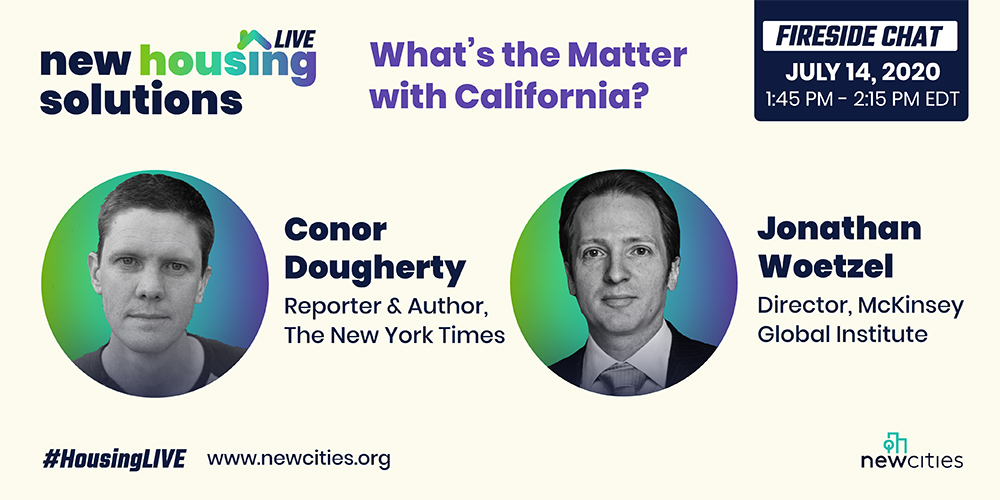
“What‘s the matter with California?” was a tête-à-tête between Mckinsey Global Institute‘s Director, Jonathan Woetzel, and Author and Reporter at The New York Times, Conor Dougherty.
So, what exactly is the problem with California Housing? Housing costs too much in California. America‘s wealthiest and most populous state is also the least affordable. Most housing development in California is for the wealthy and while there is lots of land, it is not used for housing. Housing is an affordability problem, economic problem, and human problem that affects about half of the population of California, and disproportionately affects Southern California.
Both experts discussed the possible solutions to California’s Housing crisis and at what level the state government should be involved in housing solutions for California, especially in terms of affordability.
After-hours Session
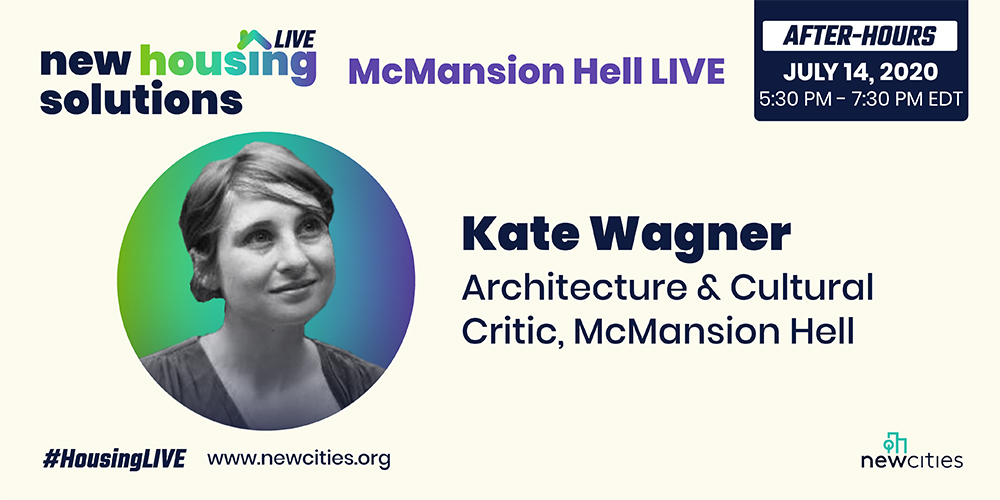
Wrapping up the first day of #HousingLIVE is McMansion Hell‘s, Kate Wagner, to roast some of the most outrageous houses for charity!